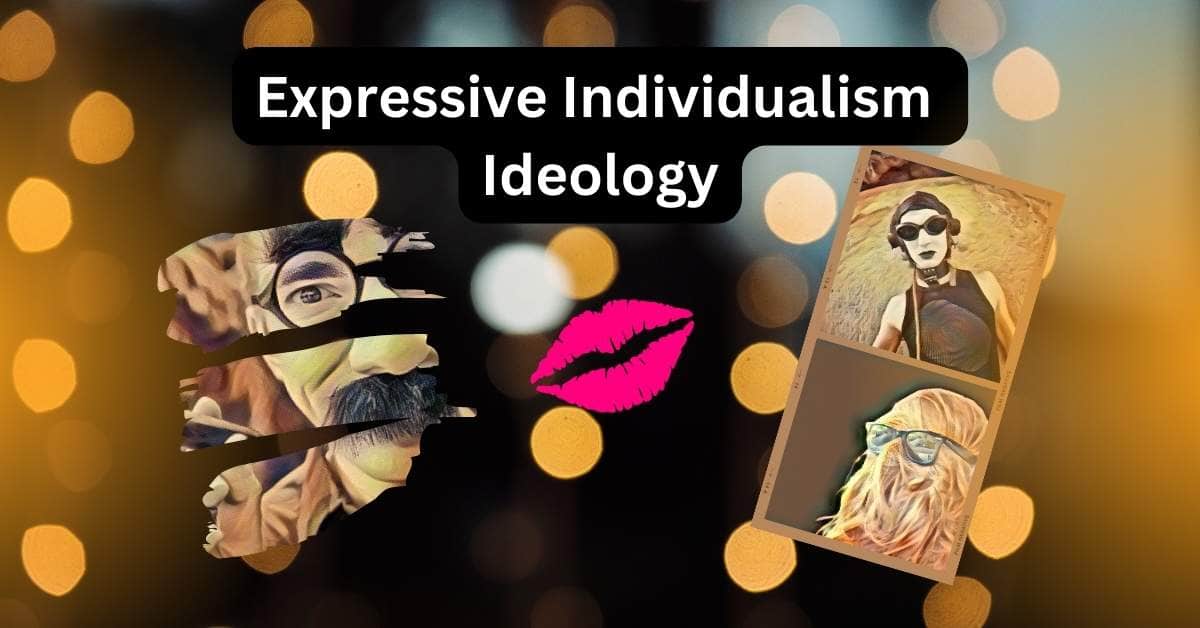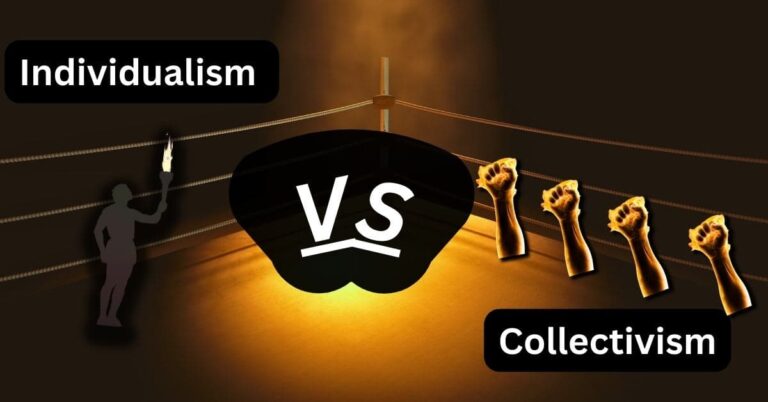Do you witness defiant or oddly dressed individuals protesting? You wonder what goes through their minds. This is expressive individualism in its most definitive form.
Expressive individualism shuns societal norms to display their sense of self. Through their external, visible fashion and behavior choices, they desire public acknowledgment. Internally, they need recognition since it is a part of their identity. Also, Robert Bellah coined this individualism.
Normally, I write about individualism through a political lens. I will shelf most of my political passion for this post.
In my research, your issues with this ideology are cultural- not entirely political. It threatens the church’s morality and stability.
What is Expressive Individualism?
The Definitions
Defining the term expressive individual needs 2 definitions.
I’ll give you a basic meaning incorporating an individualism you possess. Then, I’ll provide you with an extreme version.
Now, let’s start with the essentials.
Expressive individualism is a set of priorities displayed through advertising, media, and fashion. People gravitate to what they like. They acknowledge, express, and wear their feelings.
Basic definition of expressive individualism
Did you know we all are expressive in some form? Embrace it! This definition allows you a little grace and freedom. Laugh a little.
Culture influences advertising. Each decade included an iconic feel defining that expressive era. And you see the changes with campaign ads like Coca-Cola. The ever-developing Christmas Coke Santa Clause is a great example. His look transformed from the 1920s to now.
Media such as movies or shows also define expressive individualism. Stars from John Wayne to Angelina Jolie influenced you too. John Wayne expanded the idea of rugged individualism. Angelina Jolie influenced fashion and many young women around the world.
Young teen girls everywhere wanted to express the cool trends Jolie established.
Also, news and other broadcasting companies become the dominant force that brings artists and “expressives” to the forefront of American life.
Personally speaking, clothes and your fashion are insights into how you want people to view you.
For instance, the business attire and your 6-piece suit represent your tastes. Yes, you’re conforming a little by wearing business casual or a work uniform. But you will sneak in your expressiveness.
To rebel against your corporate overlords, you wear brightly colored socks underneath your pants. You want some resemblance of control. And you gain satisfaction expressing yourself in secret.
This first definition is a harmless style of individualism.
Now, I’ll give you a harsher classification.
These types of expressive individualists are aggressive and rebellious. For them, they want to attract attention to every action they do. Their interior selves are put on display for the world to acknowledge. They aren’t satisfied until they receive the needed recognition.
Radical definition of expressive individualism
I’ve seen churches and others label this sect of expressive individualism as:
- “extreme individualism”
- “radical individualism”
- “hyper freedom”
You feel threatened if you’re using these types of adjectives to describe this definition. Religious organizations preach this as a danger to social stability. They argue expressive individualists have extreme worship of the self.
It is a cult lacking morals and a clear direction in life. They’re unpredictable and hate societal norms.
Here are some other phrases society uses to downplay their threat:
- “Just do your own thing, boo.”
- “You be you.”
- “Live your best life.”
- “Be yourself, don’t let anyone get in your way.”
Again, we have 2 definitions. Society expects a reasonable uniqueness from everyone. However, the radicals take it to the extreme. They cause problems for existing institutions such as families or organizations.
All of the focus is on inner desires. They must outwardly express themselves and receive praise. This recognition is important to their self-esteem.
“Expressives” define their own culture. Where is America headed? LEARN MORE about where individualism fits into American culture.
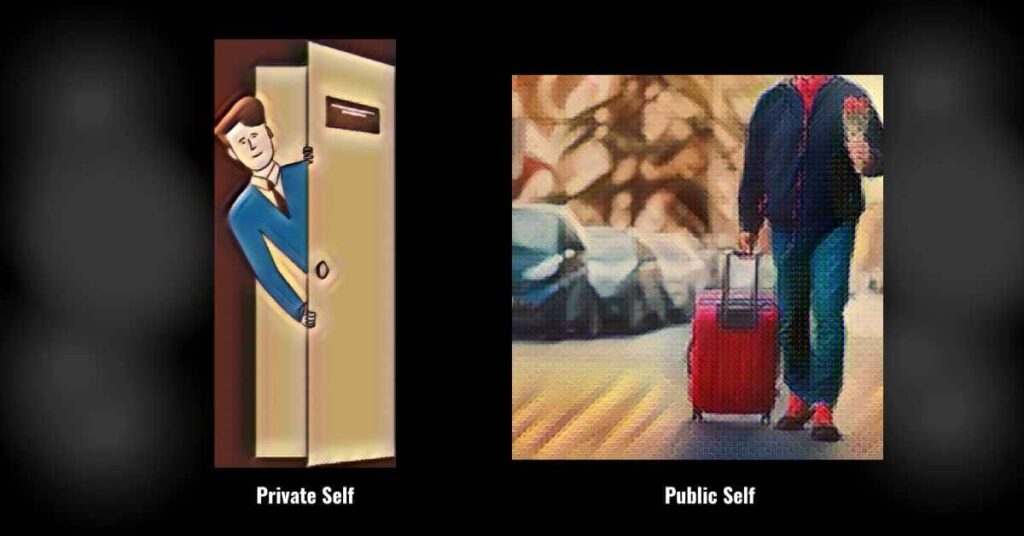
Public vs Private Self
In Robert Bellah’s Habits of the Heart, he discusses how we project our individual selves to others. You have a private vs public self.
Private Self
Americans love their privacy. It is an unenumerated right derived from the Constitution. You want to maintain your confidentiality behind closed doors.
The feelings you possess determine the self and image you portray.
For instance, you have your private self while you’re alone or with people you love. You’ll sing your favorite rock song at loud volumes while in the shower. And you won’t care who hears your awful singing. This is your “you” time. I won’t tell your secret.
Inside jokes are another great example. You’ll share intimate details of events or experiences with others in your “circle of trust”. The person walking down the sidewalk won’t know the cause of your laughter if an experience triggers the memory.
Your private self remains close to your true intentions. Only your nuclear family and friends peek into your inner soul.
Public Self
When you go to church on Sunday mornings, you dress your best. This is a perfect example of your public self. You want to express a positive public image. We all do it. There is no shame in it.
In today’s culture, social media is a case study of your “open book” identity. People spend hours shooting and editing the best photos to post on Instagram or Facebook.
Yet, on the extreme side, “expressives” must receive the recognition they need. Because their public self is directly tied to their identity. If you reject them, they take it as a personal attack.
If you’re not sure the difference between individuality vs identity, LEARN MORE by reading my post on the importance of your individuality.
Imagine you’re at a football game and someone starts a fight. As the cops take them out of the stadium, they will say, “I’m just expressing myself.”
To them, the public misinterpreted their intentions. The reason for the fight is part of their identity. They can’t separate social rejection from society’s disapproval of violence. We want peaceful coexistence.
Also, pastors and politicians alike present their public selves to the world. They represent their church or country. When you travel in a group or for an organization, you’re an ambassador displaying the best possible image.
Have you ever thought you knew someone, but in reality, you actually didn’t?
Somewhere you misunderstood the difference between the person’s public vs private self. First impressions are an important part of the public self.
Public selves determine how others interpret your actions.
Discovery of Expressive Individualism and Groups
Robert Bellah coined the term “expressive individualism”. His research helped to identify the groups many described but couldn’t explain.
Some of the sub-cultures that fit into a true expressive definition include:
- gay community
- hippies
- anarchists
Before the prominent era of expressiveness, many of these subsets remained hidden.
Expressive individualism brings artists to the forefront of society. And it normalizes the different behavior.
Fundamental Beliefs of Expressive Individualism
Reject All Social Constraints
The diehard “expressives” promotes this concept to the extreme. They don’t want any constraints on their sense of self.
Put simply, they want zero conformity. You’ll receive backlash if you question them.
The church sees a big threat to civil society because they all reject normal institutions. The nuclear family disappears with extreme expressive individualism.
Also, radical “expressives” develop their sense of what’s right or wrong. They have no morality. And they’re prone to use government power to institute new unacceptable social norms.
Check your local news. You’ll see examples of my point.
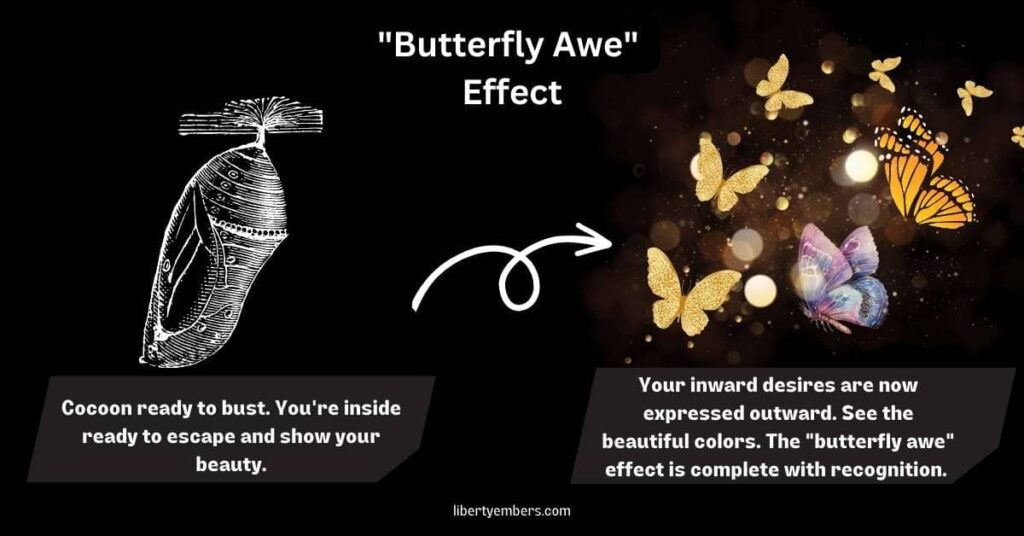
Go Inward to Express Outward
I’ll explain this concept through a butterfly analogy. Butterflies are marvelous creatures with epic colors that many admire. I call this the “Butterfly Awe” comparison.
For the cocoon of yourself to blossom, you switch all your thoughts inward. You focus on living for the moment and others’ admiration.
Once you’ve realized your feelings and are ready to hatch, you want to release the butterfly shell. It becomes important for society to recognize your external beauty.
Wild and extravagant displays of self demonstrate your outward personality. And you want others to experience that “butterfly awe” when they see you. Others’ reactions of “awe” give you appreciation. Because we can stare at butterfly beauty for hours.
Identity Attachment to Self
With expressive individualism, you attach your identity to every aspect of society. You can be a Canadian vegan heterosexual female dog lover…
In other words, your list of items that qualify your identity never ends. But there is one important aspect to identity.
If you refuse to acknowledge them, it is a direct attack on their individuality.
Charles Taylor- a prominent Canadian philosopher- called this the “Age of Authenticity”. “Expressives” don’t want their values criticized. It is an assault on their dignity and not a debatable item.
Happiness is the Ultimate End
“Expressives” use the phrase, “I’m just trying to find my happiness.” They’re referencing the Declaration of Independence’s “pursuit of happiness”.
The ultimate goal of expressive individualism is pleasure.
“No one should make me feel uncomfortable or do anything I don’t want to do.”
radical expressive individualist
An extreme version of this happiness is sexual freedom. Churches dislike the idea of unbridled “free love”. I’ll discuss this idea more below to expand on the why here.
People express themselves through their sexual desires and tendencies. Discrediting or criticizing their sexual behavior threatens their happiness.
Simply stating “I don’t like your choices” can be seen as oppressive.
There is more than the expressive individualism ideology. You haven’t see how it interacts with society. LEARN MORE about expressive individualism in society.
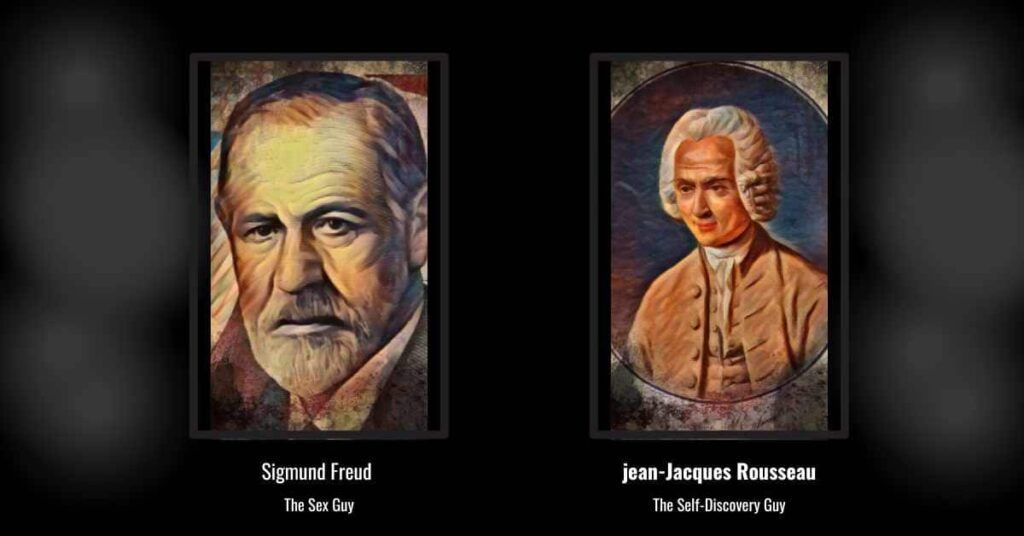
Historical Roots and Philosophical Underpinnings
This sections includes all the philosophers who have helped to define expressive individualism.
Charles Taylor
Charles Taylor wrote a book called The Secular Age in 2007. It is over 800 pages.
In chapter 13, he describes the “Age of Authenticity”. People discover their version of individualism. By realizing what’s inside, “expressives” can live a more fulfilled life.
Also, he discusses the history of the expressive movement.
Specifically, he mentions John Stuart Mills’ “no harm principle” of total liberty. You’re able to live your truest life as long as you don’t intentionally hurt other people along your journey.
He builds off the work of Robert Bellah in Habits of the Heart.
Sigmund Freud- A Sexual Man
Freud is a colorful character. He is famous for using cocaine with his patients. Some call him a sexual deviant. Also, his political clout helped him escape Nazi persecution.
In the 19th century, respect came with big discoveries. Many of his theories are refutable now. But expressive individuals cling to one of his most famous- “the pleasure principle.”
According to Freud, humans experience joy only through sex. Great pleasure leads to your happiness.
Your desire for sex is natural. But is it the only key to your happiness? Do you have an unlimited erotic appetite? Freud would say yes.
Most of the world hasn’t read Freud. But all you need is an influencer to take an idea and expand it. Hugh Hefner became that influencer.
Hefner sparked the sexual revolution. This led to the “free love” deviance you see in extreme “expressives” today.
Part of religious doctrine is chastity and saving yourself. Expressive individualism ideology doesn’t want limits placed on what they consider outdated institutions.
From a political perspective, individual rights dictate “expressives” have the liberty to do what they want. The “no-harm principle” lets them be sexual deviants.
Jean-Jacque Rousseau- Self-Discovery
Rousseau became a famous European philosopher influenced by the Age of Enlightenment. His ideas grew a more progressive society toward individual autonomy.
Not only did he push for political ideas such as the Social Contract. He developed many theories about the “self” and societal influence.
He asserts the importance of people’s dignity through self-recognition. And society must recognize this dignity. It is part of an individual’s identity.
Rousseau is responsible for the discovery of the inner self.
Conclusion
Expressive individualism’s ideology has a complicated philosophy manifesting itself today.
Many of you see it every day without realizing the technical term for it. Preachers use radical- or extreme- individualism referring to the “expressive” types.
We all are expressive in different ways. But there is a pervasiveness religious leaders dislike.
It is an ideology stressing the importance of oneself. Then, a person displays that self outwardly for public judgment and consumption.
Think of hippies and the sexual revolution culture of the 1960s as a prime example.
A movement doesn’t start and end overnight. If you oppose expressive individualism, challenge the ideology from a cultural viewpoint-not an individual rights perspective. It is possible to set boundaries and policies not affecting people’s rights.
Is expressive individualism a new term for you? Do you think this individualism is a threat to your lifestyle today?
J. Liberty
An opposite approach to expressive individualism is collectivism. LEARN MORE as I describe the basics between the collective vs the individuality of you.
References:
Bellah, R. N., Madsen, R., Sullivan, W., Swidler, A., & Tipton, S. (1985). Habit of the Hearts: Individualism and Commitment in American LIfe. Los Angeles: University of California Press.
Levin, Y. (2016). The Fractured Republic: Renewing America’s Social Contract in the Age of Individualism. New York: Basic Books.
Madigan, P. (2013). Expressive Individualism, the Cult of the Artist as Genius, and Milton’s Lucifer. Studia Aloisiana, 4(1), 5-14.
Taylor, C. (2007). A Secular Age. Cambridge: The Belknap Press of Harvard University Press.
Trueman, C. R. (2020). The Rise and Triumph of the Modern Self: Cultural Amnesia, Expressive Individualism, and the Road to Sexual Revolution. Wheaton, Illnois: Crossway.
Photo Credits
Photo Credits:
© Ekaterina79 via canva.com
